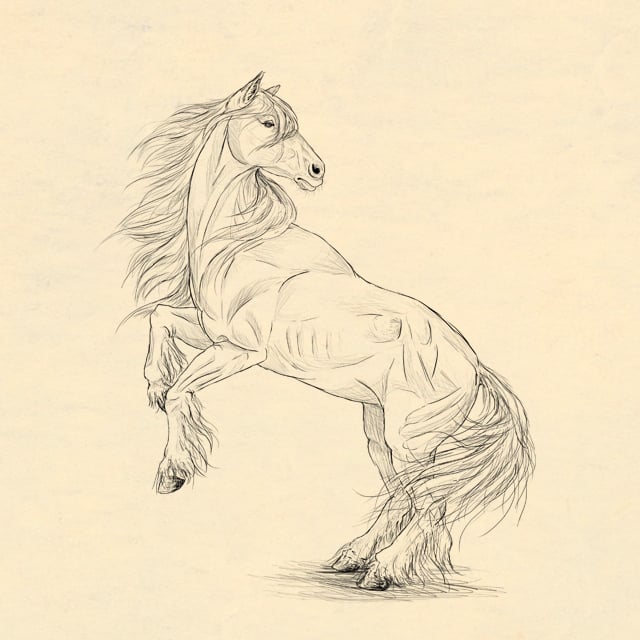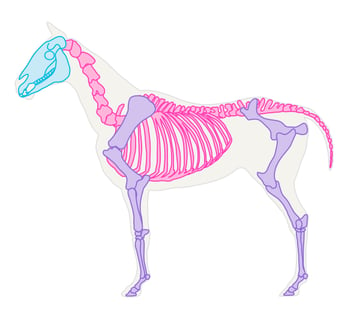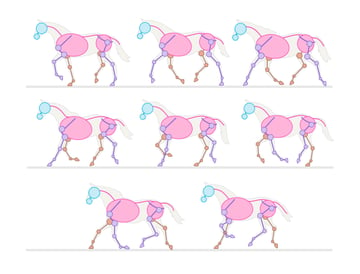how to draw a horse for adults?



Running horses are beautiful and graceful creatures. However, they can be one of the hardest animals to draw. I will show you how to draw this majestic creature, referencing their basic anatomy to make sure you create a natural pose. You'll also learn about horse gaits to draw realistic and dynamic poses.
Feel free to check some reference images of horses on Envato Market.
1. The Skeleton of a Horse
Step 1
A skeleton is the base for a whole body, so we need to learn it to understand the animal's movement and poses. But don't worry, you're not supposed to count the ribs. Just take a good look at this.



Step 2
Use the skeleton to see the basic structure of every pose. Remember all the joints (circles) and bones (lines), their placement and proportions between them, and you're able to draw every horse!



Step 3
It's important to remember that hooves aren't feet - they're fingers. Actual feet start at the joints that looks like knees and elbows to us. So, a horse doesn't have a knee in the forelegs - it's a wrist!



Step 4
A pony is a horse too. Just remember it has a shorter neck and legs - the rest stays the same.



Step 5
A foal is the opposite to a pony - just look at its unproportionally long legs!



2. A Look at Horse Poses
Now you know how to draw a stationary horse, but let's be honest - it's boring. To bring a pose to life you need to understand how horses move, and, more importantly, how they don't. If you guess the pose, you may accidentally confuse trot with gallop, making the picture unrealistic, no matter how much time you have spent on drawing the muscles and light reflexes.
Step 1
A "walk" is first and the slowest horse movement. In this pose a horse is standing on the ground with three feet, while one foot is raised. It's a four-beat gait (four knocks can be heard).






Step 2
Trot is a kind of gait that horses use for long distances. In this pose a horse moves its legs in diagonal pairs, in a two-beat rhythm.






Step 3
Canter is faster than a trot, but slower than a gallop. It's a three-beat gait, and a horse uses one of its hind legs to move the others forward.






Step 4
A gallop is very similar to canter, but it's faster and uses a four-beat rhythm. Also, there's a mistake that used to be done by masters of painting. Do you remember painted horses in gallop, with all the legs stretched in the air? It doesn't work like this. When a horse is extending its legs, at least one of them stays on the ground. The "suspension" phase happens when all the legs are bent under the body.












Step 5
A very cool, yet a bit uncomfortable pose for a horse is prancing. This pose is very hard to maintain for a longer time, and it works like a jump of excitement for a horse. To draw it naturally, you need to place the hind legs at a correct angle.



Step 6
Horses are able to sleep in standing position, but it doesn't mean they can't lay down. Actually, they need to lay down to take a real rest. They usually lay on one side, with legs bent, but they can also sleep "flat", with whole body relaxed.






Step 7
Horses look very gracefully when jumping. Also, when a horse is being suspended in the air, its pose is perfect for a flying Pegasus.






Step 8
So, that was all about the poses. You can now choose your own for your picture.



3. The Muscles of a Horse
Step 1
Muscles give shape to the body, so you need to learn them too. Unfortunately, a horse's muscular body can be seen very clearly under the skin, so if you'll want to skip this step, your horses will never look realistic.
If you want to draw a horse quickly, here comes a simplified scheme. It will let you draw a good shape of the body without diving into details.



Step 2
Here comes a more complicated structure. It's all you need to draw a believable body. You may think you won't ever need it, but without them the skin would be flat.






Step 3
Add muscles to your pose.



Step 4
Next thing is the skin. It covers the muscles, hiding the sharp borders between them. The bulges of muscles under the skin reflect the light individually, making the body surface irregular and full of depth.



Step 5
Horse breeds can be divided into hot-bloods, cold-bloods, and warm bloods. Hot-bloods are slim, long-legged and nobly looking (think Arabian horses), fast and intelligent. Cold-bloods are typical draft horses (like these from Skyrim) - big, heavy and muscular, but also slow-thinking and gentle. Warm bloods are a mixture of both.



Step 6
Erase the lines of muscles that touch each other.



4. Draw the Hooves of a Horse
Step 1
Hooves are, in fact, a horse's nails. Horses are odd-toed, which means their hooves aren't split. Drawing split hooves is permissible only if your horse is going to be a unicorn.
To draw a hoof from the side view, draw a line extending the leg's length. Then draw a rhombus touching the line with one corner.



Step 2
Cover the rhombus with a kind of cap.



Step 3
Create an outline over these shapes.



Step 4
Add a bit of hair and draw a rough texture of a nail.



Step 5
To draw a hoof from the front, draw a rounded, slightly tapered shape at the bottom of the line.



Step 6
Cover it with a cap.



Step 7
Create the outline, as before.



Step 8
Add the hair and textures. It's done!



Step 9
Drawing a hoof from the back is equally easy. Start with the same rounded shape like before, but this time make the cap big and falling.



Step 10
Create the outline.



Step 11
Again, add the hair and texture.



Step 12
My horse now has hooves.



5. Draw a Horse Head
Step 1
To draw a head from profile, start with three circles - one for the main part of the skull, one for the muzzle and one for a nostril.



Step 2
Connect the circles and add an ear.



Step 3
Divide the "muzzle" circle into three parts to draw the lips.



Step 4
Draw a nostril inside the "nostril" circle and draw two lines from the nostril to the ear.



Step 5
Draw a line laying on the two muzzle circles, then divide the main circle into halves with a line parallel to it.



Step 6
Divide the upper half into halves again. Use the guide lines you've just created to place the eye. If you're drawing a foal, make the eye bigger.



Step 7
Now you can sketch the details, including the muscles under the skin. Remember the cheeks are flat, not really round.



Step 8
To draw a horse head from the front, start with an oval and a circle.



Step 9
Add the nostrils, using a guide line across the circle.



Step 10
Connect the oval and the circle, add the ears and the forehead.



Step 11
Add the eyes, using guide lines splitting the oval to fourths.



Step 12
Add the details, using the head anatomy for more realistic look.



6. Draw Horse Eyes
Step 1
Draw a circle and divide it into four sections. Cross it with a line to cut it in half, then add another line just above it.



Step 2
Draw a lemon shape using the guide lines.



Step 3
Draw the eyelids.



Step 4
Draw the eyelashes. They should be straight and dense.



Step 5
The pupil should be horizontal, but most likely it won't be visible at all from distance, since horses have rather dark, brown eyes. If you're drawing a whole horse and the eye is just a detail, draw it all black. You'll need to add the pupil only if the eye is blue.



Step 6
Draw and shade the area around the eye. It's very important for its overall shape. Also, add a shine to the eyelashes to make them stand out.



Step 7
To draw an eye from the front, start with a vertical ellipse and proper guide lines.



Step 8
Add the eyelids.



Step 9
Draw the eyeball covered with upper eyelid.



Step 10
Add the eyelashes.



Step 11
Draw the pupil.



Step 12
Add a final polish to the eye.



7. Draw Horse Ears
Step 1
To draw a horse ear, start with a circle (or a half of it, if it's a front view), then divide it into four parts and use them as guide lines.






8. Draw a Horse Muzzle
Step 1
A horse's nostrils are quite big, they also can open wider when there's need for more oxygen. The easiest way to draw them is to remember they shape - they look like a 6 number or a reversed comma. So, always start with an oval and place the "6" (or reversed 6) inside, adjusting the 6's roundness to a needed size.



Step 2
When drawing the muzzle, emphasize only the lower lip and leave the corner falling. Don't forget about whiskers too - horses have a lot of them!



Step 3
It's my horse with his head added.



9. Horse Hair
Step 1
A horse's mane grows in a straight line. The strands are usually consistent in length, and they're dense enough to cover one side of the neck.



Step 2
A horse tail is actually much shorter than it seems. There are long strands of hair growing out of it, and they can be moved only with the tail.



Step 3
Very long hair covering the hooves is called feathering. It's characteristic for draft horses.



Step 4
Wind makes the mane fabulous!



You're Done!
That was a long tutorial, but I'm sure now you're a horse expert!
how to draw a horse for adults?
Source: https://design.tutsplus.com/articles/how-to-draw-animals-horses-their-anatomy-and-poses--vector-18887
Posted by: blanfordhendis.blogspot.com

0 Response to "how to draw a horse for adults?"
Post a Comment